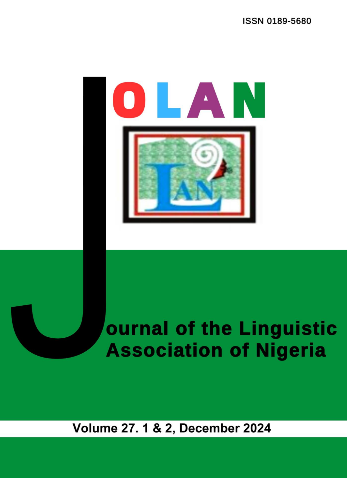Cultural Conceptualisations of Animal Names: A Semantics Perspective
Keywords:
Animal word, Concept; Culture, ThoughtAbstract
Animal words have gradually and unconsciously become part of everyday language especially in describing people’s characteristics, attitudes and behaviours, and this has got an established connotative meaning in all human languages. Several animals are conceptualised in the minds of language users as a result of their linguistic and cultural experiences and these created schemas are linguistically translated through sense reference thus, producing language which is metaphorically structured. Animal names do not mean the same to all cultures; some share a meaning, while others vary in the meanings they give to a given animal. This study has revealed that the connotative meaning of some animal names are shared by some languages, whereas the conceptual meaning some of the animal names vary among languages because of the differences in their culture, geographical environment, convention, occupation and religion. This difference in conceptual meaning raises a linguistic problem among users of English who come from different linguistic background. Using Sapir-Whorf’s (1956) Linguistic Relativity as the framework, this study has discovered that although some animal names share similar meanings among various languages in Nigeria, the meanings some animals connote in one Nigerian language differ from that of other Nigerian languages. This study used questionnaires, interviews as well as oral and written texts to examine the different connotative meanings of animals.
References
Anjomshoa, L. and Sadighi, F. (2015). The Comparison of Connotative Meaning in Animal Words between English and Persian Expressions and their Translation. In International Journal on Studies in English Language and Literature (IJSELL) Volume 3, Issue 2, February 2015, PP 65-77.
Arunachalam, S. and Waxman, S. R. (2010). ‘Specifying the Role of Linguistic Information in Verb Learning’. In K. Franich, K. Iserman, and L. Kiel (Eds.) Proceedings of the 34th Annual Boston Conference on Language Development. Somerville, MA: Cascadilla Press.
Budson, M. D. and Price, M. D. (2005). Memory Dysfunction. New England Journal of Medicine, 352,629-699.
Davies, E. E. and Bentahila, A., (1989). Familiar & Less Familiar Metaphors. Language & communication 9, 49-68.
Eggins, S. (2004). An Introduction to Systemic Functional Linguistics. 2nd Ed. Continuum.
Estaji, A. &Nakhavali. F. (2011). Semantic Derogation in Persian Animal Proverbs. Theory and Practice in Language Studies, Vol. 1, No. 9, pp. 1213-1217. ACADEMY PUBLISHER
Estaji, A. & Nakhavali. F. (2011). Contrastive Analysis of Dog Expression in English and Persian. In American Society for Engineering Education, Vol. 4, No. 3, pp. 13-21.
Fauconnier, G., & Turner, M. (1998). Conceptual Integration Networks. In Cognitive Science, pp. 133-187.
Fraser, B. (1981). Insulting Problems in a Second Language. TESOL Quarterly 15, 435-441.
Gentner, D. (1983). Structure-mapping: A theoretical framework for analogy. Cognitive Science, 7, pp. 155-170.
Glucksberg, S., and Keysar, B. (1993). How metaphors work. In Ortony (ed.), Metaphor and Thought, pp. 401-424, New York, NY: Cambridge University Press.
Halliday, M.A.K. (1985). An Introduction to Functional Grammar. London: Arnold.
Haspelmath. M. and Sims, A. (2010). Understanding Morphology. London: Hodder Education
Hsieh, S. Y. (2006). A Corpus – Based Study on Animal Expressions in Mandarin Chinese and German. Journal of pragmatics 38, 2206-2222.
Hsieh,S. Y.( 2008).“ Cognitive Models of Using Animal and Plant Metaphors” NCKU FLLD Monograph Series Vol.1.Languages across Cultures. National Cheng kung University.
Hudson, R. A. (2003). An Introduction to Sociolinguistics. Cambridge: Cambridge University Press.
Kovecses, Z. (2000). Metaphor and Emotion: Language, Culture, and Body in Human Feeling. Cambridge: Cambridge University Press.
Kripke, S. (1980). Naming and Necessity. Oxford: Blackwell.
Lakoff, G. (1987). Women, Fire and Dangerous Things: What Categories Reveal About the Mind. Chicago: University of Chicago Press.
Lakoff, G. (1993). The Contemporary Theory of Metaphor. In Orthony, (ed.) Metaphor and Thought (2nd edition) pp. 202 -251, New York, NY: Cambridge University Press.
Lakoff, G. and Johnson, M. (1980). Metaphors We Live By. Chicago: University of Chicago press.
Lyons, J. (1977). Semantics. (2 vols.) Cambridge: Cambridge University Press.
Nadim, M. (2000). The Role of Animals in Shirazi Proverbs with Sociolinguistic Approach. First Publishers First Volume, Daneshgah publication.
Newmark, P. (1988). Approaches to Translation. Prentice Hall, Hemel Hempstead
Palmer, F. R. (1996). Semantics, second edition. Cambridge: Cambridge University Press.
Saeed, J. I. (2003). Semantics, second edition. India: Blackwell.
Sapir, E. (1929). ‘The Status of Linguistics as a Science’, Language 5, 207-14.
Strawson, P. F. (1950). ‘On Referring’. Mind, New Series, Vol. 59:235, pp. 320-344.
Tomita, S. (2000). “Rhetorical Expressions by Simile in David Copperfield”. www.dickens.jp>archive>dc-tomita. Retrieved 3rd September, 2016.
Whorf, B. L. (1956). Language, Thought and Reality: Selected Writings of Benjamin Lee Whorf, ed. J. B. Carroll. Cambridge, Mass.: MIT Press.
Yan-hua, T. (2010). ‘A Study on Cultural Connotations between Chinese and English Animal Words’, Studies in Literature and Language Vol. 1, No. 4, 2010, pp. 62-69














